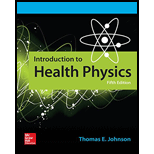
Concept explainers
(a)
To calculate: The radius of the first Bohr Orbit.
(a)
Answer to Problem 3.3P
Explanation of Solution
Given:
A µ-meson has a charge of
Formula used:
The formula to find the radii of the electronic orbits is:
Calculation:
Here,
n = 1
Substituting the values in the formula of radii of the electronic orbits,
Conclusion:
The radius is
(b)
To calculate: The ionization potential.
(b)
Answer to Problem 3.3P
E = 2.8 x 103 eV
Explanation of Solution
Given:
A µ-meson has a charge of
Formula used:
The total energy in any permissible orbit is:
Calculation:
Here,
Substituting the values in the formula of total energy,
Conclusion:
The ionization potential
Want to see more full solutions like this?
Chapter 3 Solutions
Introduction To Health Physics
- What is the maximum kinetic energy of an electron such that a collision between the electron and a stationary hydrogen atom in its ground state is definitely elastic?arrow_forwardExplain how a hydrogen atom in the ground state (l = 0) can interact magnetically with an external magnetic field.arrow_forwardWhat is the probability of the electron in the 1s state of the hydrogen atom being at a radius greater than the Bohr radius a0?arrow_forward
- The x-ray spectrum is for 35.0 keV electrons striking a molybdenum (Z= 42) target. If you substitute a silver (Z = 47) target for the molybdenum target, will (a) lmin, (b) the wavelength for the Ka line, and (c) the wavelength for the Kb line increase, decrease, or remain unchanged?arrow_forwardThe energies for an electron in the K, L, and M shells of the tungsten atom are -69,500 eV, -12,000 eV, and -2200 eV, respectively. Calculate the wavelengths of the Ka and Kb x rays of tungsten.arrow_forwardA beam of α particles of kinetic energy E = 10 MeV and intensity I = 1 μ A hits a lead target [A = 207, Z = 82, ρ = 1.14 x 104 kg m-3] of thickness t = 0.2 mm. We locate a counter of area S = 1 cm2 at a distance of l = 0.5 m beyond the target at the angle θ = 40°. Neglecting, when necessary, the variation of the angle on the detector find: (a) the number of incident particles per second Ri, (b) the solid angle ΔΩ under which the target sees the detector, (c) the differential cross-section at the detector, and (d) how many hits the detector counts per second.arrow_forward
- In a scattering experiment, you concentrate on Alpha particles with impact parameters b=0, 1×10^-3, and 1×10^0 mm. For which b will the behavior of the Alpha particle be very different in Thomson's and Rutherford's models and for which will it be nearly similar?arrow_forwardIt is possible that a muon be captured by a proton to form a muonic atom. A muon is identic to an electron, except when your mass, which is m = 105.7 MeV/c^2. What ia the smallest wave length for a Lyman series for this atom? Give your answer in pm.arrow_forwardWhat minimum accelerating voltage would be required to produce an x-ray with a wavelength of 70.0 pm?arrow_forward
- When zinc is bombarded with electrons accelerated through a potential difference ΔV, its x-ray spectrum contains emission peaks at 1.02 keV and 1.11 keV. Find the minimum value of ΔV in kV required to produce both of these peaks.arrow_forwardWhat is the maximum kinetic energy in eV of electrons ejected from a certain metal by 441 nm EM radiation, given the binding energy is 2.23 eV? eVarrow_forwardIf elements beyond Z = 120 are ever synthesized, electrons in these heavy atoms will begin filling a g subshell, corresponding to l = 4. How many states will be in a g subshell?arrow_forward
 Modern PhysicsPhysicsISBN:9781111794378Author:Raymond A. Serway, Clement J. Moses, Curt A. MoyerPublisher:Cengage Learning
Modern PhysicsPhysicsISBN:9781111794378Author:Raymond A. Serway, Clement J. Moses, Curt A. MoyerPublisher:Cengage Learning University Physics Volume 3PhysicsISBN:9781938168185Author:William Moebs, Jeff SannyPublisher:OpenStax
University Physics Volume 3PhysicsISBN:9781938168185Author:William Moebs, Jeff SannyPublisher:OpenStax Principles of Physics: A Calculus-Based TextPhysicsISBN:9781133104261Author:Raymond A. Serway, John W. JewettPublisher:Cengage Learning
Principles of Physics: A Calculus-Based TextPhysicsISBN:9781133104261Author:Raymond A. Serway, John W. JewettPublisher:Cengage Learning


